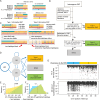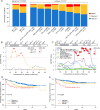Inferring chromosome segregation error stage and crossover in trisomic disorders with application to Down syndrome
- PMID: 40628699
- PMCID: PMC12238278
- DOI: 10.1038/s41467-025-61413-w
Inferring chromosome segregation error stage and crossover in trisomic disorders with application to Down syndrome
Abstract
Errors in chromosome segregation during gametogenesis, such as nondisjunction (NDJ) errors, have severe consequences in human reproduction, and a better understanding of their etiology is of fundamental interest in genetics. Mapping NDJ errors to meiotic/mitotic stages typically requires proband-parent comparison, limiting its applicability. Herein, we develop Mis-segregation Error Identification through Hidden Markov Models (MeiHMM), a method for inferring NDJ error stage and crossover events based on only genomic data of trisomic probands. Guided by triallelic genotype/haplotype configurations, MeiHMM discerns the allelic origin at each locus, which informs NDJ error during gamete formation, without identifying the parental origin of the trisomy. In 152 Down syndrome (DS) cases, MeiHMM achieved an accuracy of 96.1% in classifying NDJ errors, with a sensitivity of 91.6% in crossover identification, compared to proband-parents trio analysis. 17% of Meiosis II errors were misclassified as Meiosis I, mainly due to small proximal crossover events. Applying MeiHMM to 509 children with DS-associated childhood leukemia, we demonstrate that NDJ error is associated with the age of disease onset, somatic genomic abnormalities, and prognosis. Thus, MeiHMM is an effective method for trisomic NDJ error classification and crossover identification that can be applied broadly to study the etiology of congenital aneuploidy conditions.
© 2025. The Author(s).
Conflict of interest statement
Competing interests: The authors declare no competing interests.
Figures



References
-
- Bull, M. J. Down syndrome. N. Engl. J. Med.382, 2344–2352 (2020). - PubMed
-
- Antonarakis, S. E., Avramopoulos, D., Blouin, J. L., Talbot, C. C. & Schinzel, A. A. Mitotic errors in somatic-cells cause trisomy-21 in about 4.5-percent of cases and are not associated with advanced maternal age. Nat. Genet.3, 146–150 (1993). - PubMed
-
- Antonarakis, S. E. Parental origin of the extra chromosome in trisomy 21 as indicated by analysis of DNA polymorphisms. Down Syndrome Collaborative Group. N. Engl. J. Med.324, 872–876 (1991). - PubMed
MeSH terms
Grants and funding
LinkOut - more resources
Full Text Sources
Medical

